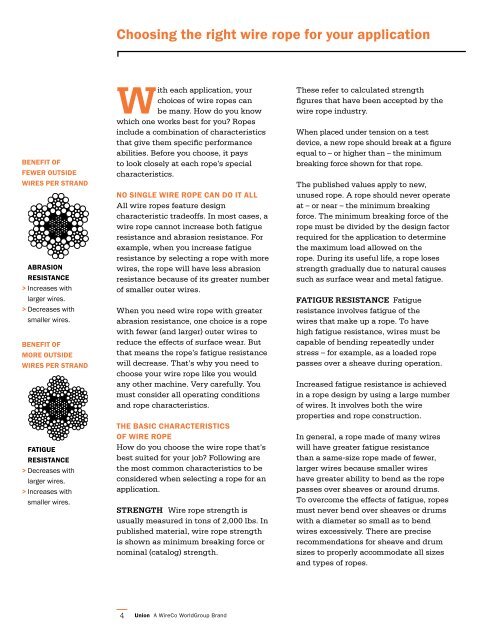Crane User's Guide - Union Wire Rope
Crane User's Guide - Union Wire Rope
Crane User's Guide - Union Wire Rope
You also want an ePaper? Increase the reach of your titles
YUMPU automatically turns print PDFs into web optimized ePapers that Google loves.
enefit of<br />
fewer oUtside<br />
wires Per strand<br />
abrasion<br />
resistanCe<br />
> Increases with<br />
larger wires .<br />
> Decreases with<br />
smaller wires .<br />
benefit of<br />
more oUtside<br />
wires Per strand<br />
fatigUe<br />
resistanCe<br />
> Decreases with<br />
larger wires .<br />
> Increases with<br />
smaller wires .<br />
Choosing the right wire rope for your application<br />
With each application, your<br />
choices of wire ropes can<br />
be many. How do you know<br />
which one works best for you? <strong>Rope</strong>s<br />
include a combination of characteristics<br />
that give them specific performance<br />
abilities. Before you choose, it pays<br />
to look closely at each rope’s special<br />
characteristics.<br />
no single wire roPe Can do it all<br />
All wire ropes feature design<br />
characteristic tradeoffs. In most cases, a<br />
wire rope cannot increase both fatigue<br />
resistance and abrasion resistance. For<br />
example, when you increase fatigue<br />
resistance by selecting a rope with more<br />
wires, the rope will have less abrasion<br />
resistance because of its greater number<br />
of smaller outer wires.<br />
When you need wire rope with greater<br />
abrasion resistance, one choice is a rope<br />
with fewer (and larger) outer wires to<br />
reduce the effects of surface wear. But<br />
that means the rope’s fatigue resistance<br />
will decrease. That’s why you need to<br />
choose your wire rope like you would<br />
any other machine. Very carefully. You<br />
must consider all operating conditions<br />
and rope characteristics.<br />
the basiC CharaCteristiCs<br />
of wire roPe<br />
How do you choose the wire rope that’s<br />
best suited for your job? Following are<br />
the most common characteristics to be<br />
considered when selecting a rope for an<br />
application.<br />
Strength <strong>Wire</strong> rope strength is<br />
usually measured in tons of 2,000 lbs. In<br />
published material, wire rope strength<br />
is shown as minimum breaking force or<br />
nominal (catalog) strength.<br />
4<br />
These refer to calculated strength<br />
figures that have been accepted by the<br />
wire rope industry.<br />
When placed under tension on a test<br />
device, a new rope should break at a figure<br />
equal to – or higher than – the minimum<br />
breaking force shown for that rope.<br />
The published values apply to new,<br />
unused rope. A rope should never operate<br />
at – or near – the minimum breaking<br />
force. The minimum breaking force of the<br />
rope must be divided by the design factor<br />
required for the application to determine<br />
the maximum load allowed on the<br />
rope. During its useful life, a rope loses<br />
strength gradually due to natural causes<br />
such as surface wear and metal fatigue.<br />
FAtIgue reSIStAnce Fatigue<br />
resistance involves fatigue of the<br />
wires that make up a rope. To have<br />
high fatigue resistance, wires must be<br />
capable of bending repeatedly under<br />
stress – for example, as a loaded rope<br />
passes over a sheave during operation.<br />
Increased fatigue resistance is achieved<br />
in a rope design by using a large number<br />
of wires. It involves both the wire<br />
properties and rope construction.<br />
In general, a rope made of many wires<br />
will have greater fatigue resistance<br />
than a same-size rope made of fewer,<br />
larger wires because smaller wires<br />
have greater ability to bend as the rope<br />
passes over sheaves or around drums.<br />
To overcome the effects of fatigue, ropes<br />
must never bend over sheaves or drums<br />
with a diameter so small as to bend<br />
wires excessively. There are precise<br />
recommendations for sheave and drum<br />
sizes to properly accommodate all sizes<br />
and types of ropes.


